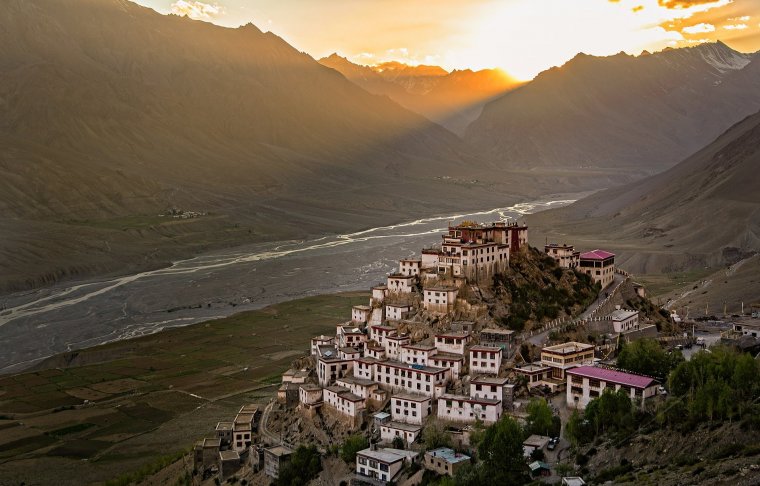| Published in Attractions / Temples, Ashrams, Monasteries |
Key Monastery, Himachal Pradesh, India
Gelug Tradition, 11th century, about 350 monks.
Kye Gompa (also spelled Ki, Key or Kee) is a Tibetan Buddhist monastery of the Gelug tradition. It is the largest and oldest monastery of the Spiti Valley and a religious training centre for lamas. It reportedly had 100 monks in 1855 and about 350 monks in 2014.

Key Monastery. Photo: Pranav, Wikipedia.
Location
The monastery located on top of a hill at an altitude of 4,166 metres, in the Spiti Valley of Himachal Pradesh, India.
History
Kye Gompa is said to have been founded by Dromtön (Brom-ston, 1008-1064 CE), a pupil of the famous teacher, Atisa, in the 11th century.
This may, however, refer to a now destroyed Kadampa monastery at the nearby village of Rangrik, which was probably destroyed in the 14th century when the Sakya sect rose to power with Mongol assistance.
Kye was attacked again by the Mongols during the 17th century, during the reign of the Fifth Dalai Lama, and became a Gelugpa establishment. In 1830, it was sacked again during the wars between Ladakh and Kulu.
In 1841, it was severely damaged by the Dogra1 army under Ghulam Khan and Rahim Khan.
Later that same year, it suffered more damage from a Sikhs. In the 1840s, it was ravaged by fire and, in 1975, a violent earthquake caused further damage which was repaired with the help of the Archaeological Survey of India and the State Public Works Department.
Features
The walls of the monastery are covered with paintings and murals, an example of the 14th century monastic architecture. Key is the repository of the rare thangka paintings and several ancient musical instruments - trumpets, cymbals, and drums. Its library has the manuscripts of the sacred Tangyur texts.
There are three floors, the first one is mainly underground and used for storage. One room, called the Tangyur is richly painted with murals. The ground floor has the beautifully decorated Assembly Hall and cells for many monks.
The monastery of Kee accommodates nearly 350 monks, who reside there throughout the year. Some monks go to South Indian Monasteries during winters.
The monastery heads are considered reincarnations of Guru Rinpoche. The current head of Key Monastery is from Kinnaur district of Himachal Pradesh. He is 19th birth of Guru Rinpoche.
A celebration of its millennium was conducted in 2000 in the presence of the Dalai Lama. A new Prayer Hall was inaugurated in August 2000 by the Dalai Lama.
In recent times the monastery has also hosted the "Kachen Dugyal Memorial Old Aged - Handicapped Society" which provide accommodation for several elderly and handicapped people.
A new prayer hall was inaugurated in year 2000 by the His Holiness the 14th Dalai Lama, under the patronage of Pritzker family.2

Statues at Kye Monastery Photo: Anubhav Agarwal
Festivals
The Cham dance is a lively masked and costumed dance accompanied by music played by monks using traditional Tibetan musical instruments. The dances often offer moral instruction relating to karuṇā (compassion) for sentient beings and are held to bring merit to all who perceive them.
Chams are considered a form of meditation and an offering to the gods.
The leader of the cham is typically a musician, keeping time using some percussion instrument like cymbals, the one exception being Dramyin Cham, where time is kept using dramyin, a traditional Himalayan folk music lute with six strings. This annual event takes place in June or July.
Travel and Visiting
Kye Monastery is about 12 km north of Kaza and 170 km from Manali by road. The nearest airport to Manali is at Bhuntar, located approximately 50 kilometres away. Domestic flights connect Bhuntar with Delhi and Chandigarh.
Key Monastery is also accessible from Shimla, which is 435Km away.
The best time to visit Key Monastery is from June to early September, except for the monsoon month of August, when Manali road may be closed due to increased landslide risk.
Sources
• https://en.wikipedia.org/wiki/Key_Monastery
• https://moustachescapes.com/blog/key-monastery-in-spiti-valley/
• https://www.india.com/travel/spiti/places-to-visit/monasteries-key-monastery/
Footnotes
1. The Dogras or Dogra people, are an Indo-Aryan ethno-linguistic group in India and Pakistan consisting of the Dogri language speakers. They live predominantly in the Jammu region of Jammu and Kashmir, and in adjoining areas of Punjab, Himachal Pradesh, and northeastern Pakistan.
2. Thomas Pritzker is an American billionaire heir, businessman and philanthropist. A member of the Pritzker family, he is the chairman and chief executive officer (CEO) of the Pritzker Organization (TPO), which manages the various Pritzker family business assets, and the executive chairman of the Hyatt Hotels Corporation.
YOU MAY ALSO LIKE






 If you own or manage a travel-related business such as a hotel, a bed-and-breakfast, a restaurant, a pub or a cafeteria, you can create a web page for your business for free on Titi Tudorancea Travel Info. » |